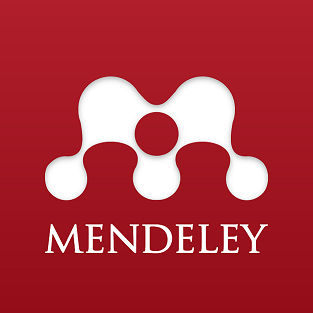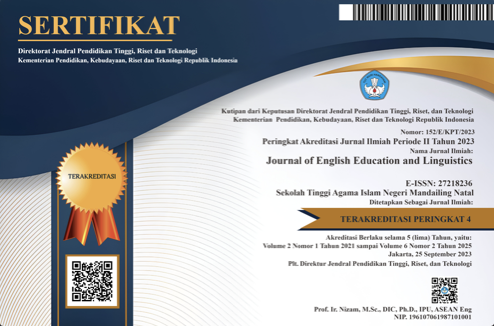Utilization of Duo lingo Application used and Practice Drilling Vocabulary Technique for Up-Grading Students’ Reading Comprehension
DOI:
https://doi.org/10.56874/jeel.v1i1.48Keywords:
Duolingo, Vocabulary, ReadingAbstract
English language has been commonly accepted as an active universal language in the world. People who study English language consider it as their personal proficiency. Therefore, nowadays many people, particularly students, ought to master English language. Mastering English language is an important value for the students to have. Refers to the condition, the researcher interested to help student to master English specially reading comprehension, and this research would find the following questions; Is there any influence of duolingo application used to the students’ reading comprehension at SMA Muhammadiyah Tanjung Redeb?, (1) Is there any influence of vocabulary enhancement to the students’ reading comprehension at SMA Muhammadiyah Tanjung Redeb?, (1) Is there any influence of duolingo application used and vocabulary enhancement to the students’ reading comprehension at SMA Muhammadiyah Tanjung Redeb?. The method of this research is partial correlation method, then to analyze the data used normality, homogeneity, linearity, partial correlation and regression equation.
References
Antonio S. Broto. (2001). “Stastistics, Made Simple”, 2nd Edition. National Bookstore.
Agus Eko Sujianto. (2007). Aplikasi Statistik dengan SPSS Untuk Pemula. Jakarta : Prestasi Pustaka.
Finocchiaro, M., & Bonomo, M. (1973). The foreign language learner: A guide for teachers. NewYork: Regents.
Grabe,W. (2009).Reading in Second Language(Moving from Theory to Practice). New York : Cambridge University Press.
Harmer, Jeremy. (1998). How to Teach English. Harlow: Longman.
Hung, D. L., & Tzeng, D. J. (1981). Orthographic variations and visual information processing. Psychological Bulletin, 90(3), 377-414.
Hung & Tzeng, (2007). Orthographic Variation and Visual Information Processing. Psychological Bulletin, 90.
http://static.duolingo.com/s3/DuolingoReport_Final.pdf
Jack C. Richards (2002) Methodology in Language Teaching an Anthology of Current Practice. Cambridge University Press
Jaskova, Veronica. 2014. Duolingo as a new language learning website and its contribution to E- Learning education. Brno. Faculty of Education Department of English Language and Literature Masaryk University.
Munday, P. (2016). The case for using DUOLINGO as part of the language
Nunan, D. (1991). Language Teaching Methodology: A Textbook for Teacher. Upper Saddle River, NJ: Prentice Hall.
Spratt, M., Pulverness, A., Williams. (2005). The teaching knowledge test course. Cambridge: Cambridge University Press.
Tarigan, Henry Guntur. 1987. Pengajaran Wacana. Bandung: Angkasa. Vesselinov, R. and J. Grego, 2012, Duolingo Effectiveness Study
Downloads
Published
Issue
Section
License
All articles published in the Journal of English Education and Linguistics are licensed under a Creative Commons Attribution-ShareAlike 4.0 International (CC BY-SA) license. This means anyone is free to copy, transform, or redistribute articles for any lawful purpose in any medium, provided they give appropriate attribution to the original author(s) and Journal of English Education and Linguistics, link to the license, indicate if changes were made, and redistribute any derivative work under the same license.
Copyright on articles is retained by the respective author(s) without restrictions. A non-exclusive license is granted to the Journal of English Education and Linguistics to publish the article and identify itself as its original publisher, along with the commercial right to include the article in a hardcopy issue for sale to libraries and individuals.
Although the conditions of the Creative Commons Attribution-ShareAlike 4.0 International (CC BY-SA) license do not apply to authors (as the copyright holder of your article, you have no restrictions on your rights), by submitting to the Journal of English Education and Linguistics, authors recognize the rights of readers and must grant any third party the right to use their articles to the extent provided by the license.

This work is licensed under a Creative Commons Attribution-ShareAlike 4.0 International License.








